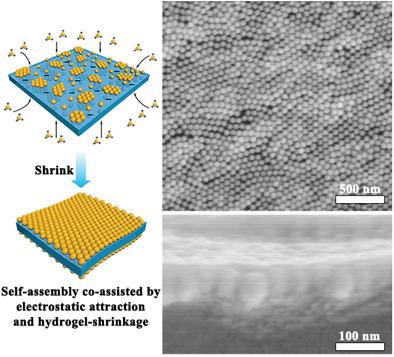当前位置:
X-MOL 学术
›
Adv. Mater. Interfaces
›
论文详情
Our official English website, www.x-mol.net, welcomes your
feedback! (Note: you will need to create a separate account there.)
Hydrogel Film@Au Nanoparticle Arrays Based on Self-Assembly Co-Assisted by Electrostatic Attraction and Hydrogel-Shrinkage for SERS Detection with Active Gaps
Advanced Materials Interfaces ( IF 4.3 ) Pub Date : 2021-08-31 , DOI: 10.1002/admi.202101055 Changchang Xing 1, 2 , Shichuan Zhong 1, 2 , Dilong Liu 1 , Tao Zhang 1 , An Cao 1, 2 , Pan Zeng 1, 2 , Dandan Men 3 , Cuncheng Li 4 , Weiping Cai 1 , Yue Li 1
Advanced Materials Interfaces ( IF 4.3 ) Pub Date : 2021-08-31 , DOI: 10.1002/admi.202101055 Changchang Xing 1, 2 , Shichuan Zhong 1, 2 , Dilong Liu 1 , Tao Zhang 1 , An Cao 1, 2 , Pan Zeng 1, 2 , Dandan Men 3 , Cuncheng Li 4 , Weiping Cai 1 , Yue Li 1
Affiliation

|
A facile route to fabricate the hydrogel film@Au nanoparticle array composite for a surface-enhanced Raman scattering (SERS) substrate with high signal sensitivity and signal uniformity based on self-assembly co-assisted by electrostatic reaction and hydrogel-shrinkage is developed. First, the positive-charged Au nanoparticles (NPs) are self-assembled on the hydrogel film with opposite charges due to electrostatic attraction to obtain non-close-packed Au NP films on both surface sides of the hydrogel film. Then, the non-close-packed Au NP films are densified to further form hexagonal close-packed Au NP arrays on both surfaces due to the principle of minimum free energy during the hydrogel-shrinkage process. The shrinkage of hydrogel film is proved to be a key process to form hexagonal close-packed Au NP arrays by densifying the non-closely packed Au NPs achieved by electrostatically self-assembled on the hydrogel film. Constructed SERS substrate exhibits high signal sensitivity, colorant molecule amaranth with a concentration as low as 10−8 m can be detected. This is caused by the uniform array structure with active gaps between neighboring NPs on a large area. Overall, this work paves a way to fabricate functional NP arrays on soft hydrogel, which will be highly helpful to prepare the micro/nano-structured devices.
中文翻译:

基于静电吸引和水凝胶收缩辅助自组装的水凝胶薄膜@Au 纳米颗粒阵列用于具有活性间隙的 SERS 检测
基于静电反应和水凝胶收缩共同辅助的自组装,开发了一种制备具有高信号灵敏度和信号均匀性的表面增强拉曼散射 (SERS) 基底的水凝胶薄膜@Au 纳米颗粒阵列复合材料的简便途径。首先,带正电的Au纳米颗粒(NPs)由于静电引力自组装在带相反电荷的水凝胶薄膜上,从而在水凝胶薄膜的两面获得非密堆积的Au NP薄膜。然后,由于水凝胶收缩过程中的最小自由能原理,非密堆积的Au NP薄膜被致密化以进一步在两个表面上形成六边形密堆积的Au NP阵列。水凝胶薄膜的收缩被证明是通过在水凝胶薄膜上静电自组装实现的非密堆积 Au NP 致密化来形成六边形密堆积 Au NP 阵列的关键过程。构建的SERS底物表现出高信号灵敏度,着色剂分子苋菜红浓度低至10 可以检测到-8 m。这是由大面积上相邻 NP 之间具有有源间隙的均匀阵列结构引起的。总的来说,这项工作为在软水凝胶上制造功能性 NP 阵列铺平了道路,这将非常有助于制备微/纳米结构器件。
更新日期:2021-09-23
中文翻译:

基于静电吸引和水凝胶收缩辅助自组装的水凝胶薄膜@Au 纳米颗粒阵列用于具有活性间隙的 SERS 检测
基于静电反应和水凝胶收缩共同辅助的自组装,开发了一种制备具有高信号灵敏度和信号均匀性的表面增强拉曼散射 (SERS) 基底的水凝胶薄膜@Au 纳米颗粒阵列复合材料的简便途径。首先,带正电的Au纳米颗粒(NPs)由于静电引力自组装在带相反电荷的水凝胶薄膜上,从而在水凝胶薄膜的两面获得非密堆积的Au NP薄膜。然后,由于水凝胶收缩过程中的最小自由能原理,非密堆积的Au NP薄膜被致密化以进一步在两个表面上形成六边形密堆积的Au NP阵列。水凝胶薄膜的收缩被证明是通过在水凝胶薄膜上静电自组装实现的非密堆积 Au NP 致密化来形成六边形密堆积 Au NP 阵列的关键过程。构建的SERS底物表现出高信号灵敏度,着色剂分子苋菜红浓度低至10 可以检测到-8 m。这是由大面积上相邻 NP 之间具有有源间隙的均匀阵列结构引起的。总的来说,这项工作为在软水凝胶上制造功能性 NP 阵列铺平了道路,这将非常有助于制备微/纳米结构器件。


















































 京公网安备 11010802027423号
京公网安备 11010802027423号